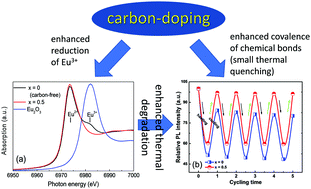Structural evolutions and significantly reduced thermal degradation of red-emitting Sr2Si5N8:Eu2+via carbon doping
Abstract
A red-emitting nitridosilicate phosphor, Sr2Si5N8:Eu2+, shows very promising photoluminescence properties but exhibits serious thermal degradation, thus making it difficult to be used practically as a color converter in white light-emitting diodes (wLEDs). To alleviate this problem, we introduce carbon into the Sr2Si5N8 lattice to form thermally robust carbidonitride phosphors (Sr2Si5CxN8−4x/3:Eu2+). The carbon doping, evidenced by a variety of analytical techniques, leads to structural evolutions including lattice shrinkage, shortening of the average bond length of Eu–(C,N), and the removal of Eu3+ ions from the lattice. The photoluminescence intensity and quantum efficiency of phosphors are greatly improved by the carbon doping and reach the maximum at x = 0.5, dominantly owing to the enhanced absorption of Eu2+. Thanks to the increased oxidation resistance of Eu2+ due to the stronger covalency of Si–(C,N) and Sr(Eu)–(C,N) bonds, thermal degradation is significantly reduced from 16 to 0.8% when the carbon doping increases from x = 0 to 1.25. In addition, thermal quenching is also reduced by 10% at 300 °C and the quantum efficiency declines slowly with increasing temperature when carbon is substituted for nitrogen. At 300 °C, the internal quantum efficiencies are 55% and 62% for x = 0 and 0.5, respectively. The enhanced thermal stability of the carbon-doped sample is also confirmed by smaller variations in the luminous efficacy and color coordinates of monochromatic red LEDs.

- This article is part of the themed collection: 2017 Journal of Materials Chemistry C HOT Papers


 Please wait while we load your content...
Please wait while we load your content...